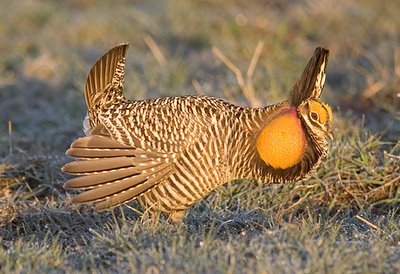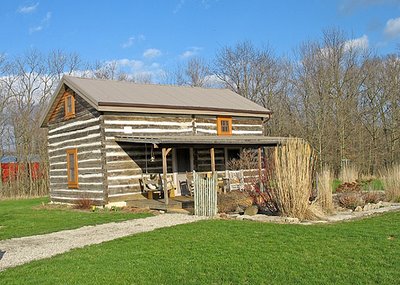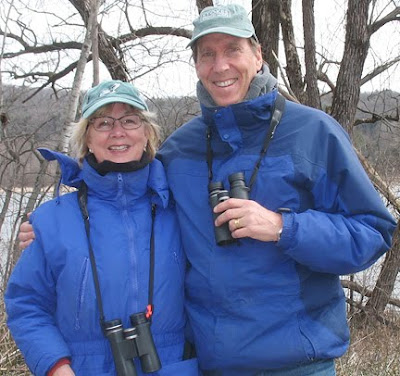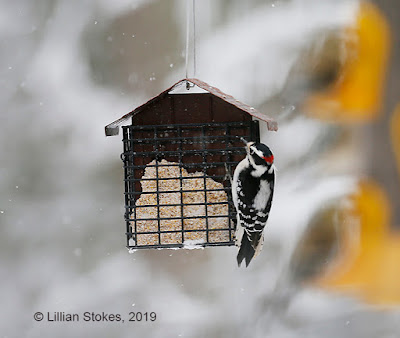American Woodcocks have arrived and are displaying at dusk! Go out to large field areas at dusk and listen for their tell-tale "peent" call. Then they launch into the air in a display and at the height give high-pitched chirping and twittering sounds. The males display in open areas to attract a female. Then they mate and she nests in the woods and raises the brood on her own.
Search This Blog
Tuesday, March 26, 2019
Friday, March 22, 2019
Greater Prairie-Chickens Amazing!

 Some years ago we were lucky to witness the wonderful mating rituals that occur this time of year for Greater Prairie-Chickens. Here is the post,
Some years ago we were lucky to witness the wonderful mating rituals that occur this time of year for Greater Prairie-Chickens. Here is the post,The next stop was Charleston, IL where we stayed in this wonderful log home bed and breakfast called Osage Inn. We got up at 3:30 am the next morning to drive to the Prairie Ridge State Natural Area, a 3,500 acre site managed by the Illinois Dept. of Natural Resources. We had to be in a blind before sunrise so as not to disturb the Greater Prairie-Chickens who come to their display ground. Males come in at dawn and begin their "booming," an incredible haunting sound that is less like booming and more reminsicent of Native American flute-like music. They rapidly stamp their feet and inflate large orange sacks on the sides of their throats. They also make other noises, including a maniacal cackling that sounds like a cross between a Pied-billed Grebe, Barred Owl, and rubber ducky. When the females arrive, the males make whooping sounds. They have what is called a "lek" mating system. Males display, then females come on the display grounds and mate with the males, then go off to lay eggs and raise the young. The whole thing was one of the more spectacular avian events we have ever witnessed. Lillian took many, many photos, here are a few more.


 We hope to show you additional photos at a later time. Tomorrow we return home to Bobolink Farm.
We hope to show you additional photos at a later time. Tomorrow we return home to Bobolink Farm.
Tuesday, March 19, 2019
Eastern Phoebe's Arriving soon, how to put out the welcome mat!
 We are waiting for our Eastern Phoebes to arrive. Even though we still have snow here in spots, spring is approaching and the weather will be in the 50's this week. Phoebes are due to arrive any day now. One of the most fun things about this time of year is that it is so full of expectations for us. So many birds will be migrating and arrive in the next 2 months. We have constructed a nesting platform for Phoebes and placed it under our deck, putting out the welcome mat. Phoebe's nest on ledges on buildings, structures, under bridges, on top of porch lights, etc. They are flycatchers and eat lots of insects so are very beneficial to your yard!
We are waiting for our Eastern Phoebes to arrive. Even though we still have snow here in spots, spring is approaching and the weather will be in the 50's this week. Phoebes are due to arrive any day now. One of the most fun things about this time of year is that it is so full of expectations for us. So many birds will be migrating and arrive in the next 2 months. We have constructed a nesting platform for Phoebes and placed it under our deck, putting out the welcome mat. Phoebe's nest on ledges on buildings, structures, under bridges, on top of porch lights, etc. They are flycatchers and eat lots of insects so are very beneficial to your yard!
Thursday, March 14, 2019
Red-winged Blackbirds have returned!
Red-winged Blackbirds have returned, the sound of spring! Welcome them. They will come to your bird feeders for mixed seed. They often nest near water in vegetation like cattails, sometimes in fields.
Tuesday, March 12, 2019
Hummingbirds are arriving, will you be ready? Here's how!
The first Ruby-throated Hummingbirds have arrived on the Gulf Coast and one has even made it as far north as North Carolina. See hummingbird 2019 migration map here.
Rubythroats will not reach northern areas until mid to end of April. Will you be ready? Here's how to attract them.
Hummingbirds are attracted to the color red. That's because the flowers they favor in nature are mainly red tubular flowers. These flowers have their own adaptations to be attractive to hummingbirds, such as they have just the right nectar concentrations and long tubes so bees cannot access the nectar. Thus they give the hummers nectar and in turn the hummingbirds carry pollen on their foreheads from one flower to another, thus pollinating the flowers.
We roll out the red welcome mat by,
- Putting up lots of hummingbird feeders with red
- Putting up hanging baskets of early red flowers such as hanging fuschia, etc. as most annuals and perennials are not blooming yet. Later we plant those flowers
- Tying red bows to the posts the hummingbird feeders hang from
- Keep feeders filled with fresh hummingbird nectar, change nectar every 2 days in hot weather.
- Keep feeders filled with fresh hummingbird nectar, change nectar every 2 days in hot weather.
Get the early hummingbirds and you may have some remain and breed. You will also attract lots of migrants that are passing through on their way to their previous breeding grounds. Even though these do not breed near you, they will remember you as a good stopping place on their next migrations.
If you live in the West, you may have had hummingbirds all year and/or lots of hummingbirds that have returned already, lucky you.
Wednesday, March 06, 2019
March Birding, welcome migrants!
One of the good things about March is the anticipation of the birds that will be migrating back soon, such as the ones we saw on this birding trip along the Connecticut River in NH and VT at the end of March several years ago.
 The highlight of the trip was the Brant (small goose on the right), spotted by Julie, found in with the Canada Geese. Brant winter in coastal areas and breed in the Arctic, they are not usually found inland in NH.
The highlight of the trip was the Brant (small goose on the right), spotted by Julie, found in with the Canada Geese. Brant winter in coastal areas and breed in the Arctic, they are not usually found inland in NH.
 Most of the birds we saw were far away, so all were photographed at quite a distance. Here's a male Mallard.
Most of the birds we saw were far away, so all were photographed at quite a distance. Here's a male Mallard.
 The Connecticut River at one of our stops. It's quite a beautiful river and a very important migration highway and breeding area for birds.
The Connecticut River at one of our stops. It's quite a beautiful river and a very important migration highway and breeding area for birds.
 When I said the birds were far away, this gives you an idea how far. The photos of the mergansers above were taken at this size in the original, uncropped photo. Can you make them out in the middle of the photo? This is the before shot of the mergansers showing their upper wings. The beauty of my new Canon 1D Mark IV camera is that it's 16 megapixels, so I am able to photograph birds that are very far away, but still crop them to usable size (72 dpi) for blog photos. Of course you have to get them in flight, as a tiny dot, in the center of the lens, with the autofocus operating, and shoot.
When I said the birds were far away, this gives you an idea how far. The photos of the mergansers above were taken at this size in the original, uncropped photo. Can you make them out in the middle of the photo? This is the before shot of the mergansers showing their upper wings. The beauty of my new Canon 1D Mark IV camera is that it's 16 megapixels, so I am able to photograph birds that are very far away, but still crop them to usable size (72 dpi) for blog photos. Of course you have to get them in flight, as a tiny dot, in the center of the lens, with the autofocus operating, and shoot.
 Lots of birders equal more fun and many eyes to spot things. Scopes were essential and people with scopes generously shared them with people who did not have them.
Lots of birders equal more fun and many eyes to spot things. Scopes were essential and people with scopes generously shared them with people who did not have them.
 We looked at other species of birds too. We pulled over at one point because someone had spotted a hawk in a tree. It exploded out of the tree and was a Cooper's Hawk.
We looked at other species of birds too. We pulled over at one point because someone had spotted a hawk in a tree. It exploded out of the tree and was a Cooper's Hawk.
 I helped this birder, find in the scope, the Barrow's Goldeneye, female. I really like to work with people to help them spot the birds. There's always an "oh, wow" moment for them when they see the cool bird everyone else is on.
I helped this birder, find in the scope, the Barrow's Goldeneye, female. I really like to work with people to help them spot the birds. There's always an "oh, wow" moment for them when they see the cool bird everyone else is on.
 Common Mergansers were plentiful. The male is below, female above. It shows her white chin and I love the red feet. We get lots of migrating Common Mergansers on the pond we live on.
Common Mergansers were plentiful. The male is below, female above. It shows her white chin and I love the red feet. We get lots of migrating Common Mergansers on the pond we live on.
 At Herrick's Cove IBA, a stop on the Vermont side of the river, birders went out on a spit of land and saw few ducks but up in the sky there were 2 Bald Eagles!
At Herrick's Cove IBA, a stop on the Vermont side of the river, birders went out on a spit of land and saw few ducks but up in the sky there were 2 Bald Eagles!
 I just took my Canon 300mm IS lens, with 1.4 teleconverter, as I wanted portability. All of the bird photos were taken, from a distance, with this, a very sharp lens.
I just took my Canon 300mm IS lens, with 1.4 teleconverter, as I wanted portability. All of the bird photos were taken, from a distance, with this, a very sharp lens.
 At Herrick's cove, we found a Black-capped Chickadee excavating a nest in a birch. Chickadees will nest in bird houses and can excavate their own nest cavity in soft, partially rotted wood.
At Herrick's cove, we found a Black-capped Chickadee excavating a nest in a birch. Chickadees will nest in bird houses and can excavate their own nest cavity in soft, partially rotted wood.
 What a riot, it's launched in mid-air, with a beakful of birch. The chickadees flew off with the excavated material and deposited it away from the nest. I hope they have a successful breeding.
What a riot, it's launched in mid-air, with a beakful of birch. The chickadees flew off with the excavated material and deposited it away from the nest. I hope they have a successful breeding.
 The last stop was near Springfield where we looked way, way across at that mountain at a rocky ledge, and saw a nesting Peregrine Falcon sitting at the nest, a white dot in the scope.
The last stop was near Springfield where we looked way, way across at that mountain at a rocky ledge, and saw a nesting Peregrine Falcon sitting at the nest, a white dot in the scope.
This birding trip, on Sun., was billed as a waterfowl safari, surveying the ducks in migration on the Middle Connecticut River, IBA (Important Bird Area) in NH (from Charlestown to Walpole) and VT (from Westminster to Springfield.) The trip was co-sponsored by the Monadnock Chapter of NH Audubon and Harris Center for Conservation Education. There were over 35 birders. We had a great time. Here's the final bird list, tallied by Julie Tilden and Phil Brown.
 The highlight of the trip was the Brant (small goose on the right), spotted by Julie, found in with the Canada Geese. Brant winter in coastal areas and breed in the Arctic, they are not usually found inland in NH.
The highlight of the trip was the Brant (small goose on the right), spotted by Julie, found in with the Canada Geese. Brant winter in coastal areas and breed in the Arctic, they are not usually found inland in NH. Most of the birds we saw were far away, so all were photographed at quite a distance. Here's a male Mallard.
Most of the birds we saw were far away, so all were photographed at quite a distance. Here's a male Mallard. The Connecticut River at one of our stops. It's quite a beautiful river and a very important migration highway and breeding area for birds.
The Connecticut River at one of our stops. It's quite a beautiful river and a very important migration highway and breeding area for birds. When I said the birds were far away, this gives you an idea how far. The photos of the mergansers above were taken at this size in the original, uncropped photo. Can you make them out in the middle of the photo? This is the before shot of the mergansers showing their upper wings. The beauty of my new Canon 1D Mark IV camera is that it's 16 megapixels, so I am able to photograph birds that are very far away, but still crop them to usable size (72 dpi) for blog photos. Of course you have to get them in flight, as a tiny dot, in the center of the lens, with the autofocus operating, and shoot.
When I said the birds were far away, this gives you an idea how far. The photos of the mergansers above were taken at this size in the original, uncropped photo. Can you make them out in the middle of the photo? This is the before shot of the mergansers showing their upper wings. The beauty of my new Canon 1D Mark IV camera is that it's 16 megapixels, so I am able to photograph birds that are very far away, but still crop them to usable size (72 dpi) for blog photos. Of course you have to get them in flight, as a tiny dot, in the center of the lens, with the autofocus operating, and shoot. Lots of birders equal more fun and many eyes to spot things. Scopes were essential and people with scopes generously shared them with people who did not have them.
Lots of birders equal more fun and many eyes to spot things. Scopes were essential and people with scopes generously shared them with people who did not have them. We looked at other species of birds too. We pulled over at one point because someone had spotted a hawk in a tree. It exploded out of the tree and was a Cooper's Hawk.
We looked at other species of birds too. We pulled over at one point because someone had spotted a hawk in a tree. It exploded out of the tree and was a Cooper's Hawk. I helped this birder, find in the scope, the Barrow's Goldeneye, female. I really like to work with people to help them spot the birds. There's always an "oh, wow" moment for them when they see the cool bird everyone else is on.
I helped this birder, find in the scope, the Barrow's Goldeneye, female. I really like to work with people to help them spot the birds. There's always an "oh, wow" moment for them when they see the cool bird everyone else is on. Common Mergansers were plentiful. The male is below, female above. It shows her white chin and I love the red feet. We get lots of migrating Common Mergansers on the pond we live on.
Common Mergansers were plentiful. The male is below, female above. It shows her white chin and I love the red feet. We get lots of migrating Common Mergansers on the pond we live on. At Herrick's Cove IBA, a stop on the Vermont side of the river, birders went out on a spit of land and saw few ducks but up in the sky there were 2 Bald Eagles!
At Herrick's Cove IBA, a stop on the Vermont side of the river, birders went out on a spit of land and saw few ducks but up in the sky there were 2 Bald Eagles! I just took my Canon 300mm IS lens, with 1.4 teleconverter, as I wanted portability. All of the bird photos were taken, from a distance, with this, a very sharp lens.
I just took my Canon 300mm IS lens, with 1.4 teleconverter, as I wanted portability. All of the bird photos were taken, from a distance, with this, a very sharp lens. At Herrick's cove, we found a Black-capped Chickadee excavating a nest in a birch. Chickadees will nest in bird houses and can excavate their own nest cavity in soft, partially rotted wood.
At Herrick's cove, we found a Black-capped Chickadee excavating a nest in a birch. Chickadees will nest in bird houses and can excavate their own nest cavity in soft, partially rotted wood.
I tried to get it coming out of the nest and tried to time the photo, getting it as it left.
 What a riot, it's launched in mid-air, with a beakful of birch. The chickadees flew off with the excavated material and deposited it away from the nest. I hope they have a successful breeding.
What a riot, it's launched in mid-air, with a beakful of birch. The chickadees flew off with the excavated material and deposited it away from the nest. I hope they have a successful breeding. The last stop was near Springfield where we looked way, way across at that mountain at a rocky ledge, and saw a nesting Peregrine Falcon sitting at the nest, a white dot in the scope.
The last stop was near Springfield where we looked way, way across at that mountain at a rocky ledge, and saw a nesting Peregrine Falcon sitting at the nest, a white dot in the scope.This birding trip, on Sun., was billed as a waterfowl safari, surveying the ducks in migration on the Middle Connecticut River, IBA (Important Bird Area) in NH (from Charlestown to Walpole) and VT (from Westminster to Springfield.) The trip was co-sponsored by the Monadnock Chapter of NH Audubon and Harris Center for Conservation Education. There were over 35 birders. We had a great time. Here's the final bird list, tallied by Julie Tilden and Phil Brown.
Canada Goose - several hundred (low), mostly at Great Meadow & Malnati Farm
BRANT - 1 Atlantic race observed in Great Meadow of Charlestown
Wood Duck - 15
Mallard - 100
American Black Duck - 40
Green-winged Teal - 30+
Common Goldeneye* - 2 females from Joy Wah Restaurant (VT)
Hooded Merganser - 10
Common Merganser - 40+
Great Blue Heron - 1 roadside
Turkey Vulture
Bald Eagle* - 3 (2i, 1a) observed from Herrick's Cove
Northern Harrier - 1 at Herrick's Cove + 1 at Great Meadow ~3 pm
Sharp-shinned Hawk - 1 Walpole
Cooper's Hawk - 2
Red-tailed Hawk
American Kestrel - 1 at Great Meadow
Peregrine Falcon* - pair at Springfield, VT ledges
Killdeer
Ring-billed Gull
Rock Pigeon
Mourning Dove
Belted Kingfisher* - 1 at Herrick's Cove
Downy Woodpecker - 1
Hairy Woodpecker - 2
Eastern Phoebe - 1 found by Ken Klapper at Great Meadow
Blue Jay
American Crow
Common Raven - 3
Black-capped Chickadee - 1 excavating nest hole at Herrick's Cove
Red-breasted Nuthatch - 1
Golden-crowned Kinglet
Eastern Bluebird - 5+ in a few places
American Robin
European Starling
Song Sparrow - 20+ on the ground at once at Herrick's Cove alone
White-throated Sparrow - Great Meadow
Dark-eyed Junco
Northern Cardinal
Red-winged Blackbird
Brown-headed Cowbird
Common Grackle
House Finch
American goldfinch
House sparrow
BRANT - 1 Atlantic race observed in Great Meadow of Charlestown
Wood Duck - 15
Mallard - 100
American Black Duck - 40
Green-winged Teal - 30+
Common Goldeneye* - 2 females from Joy Wah Restaurant (VT)
Hooded Merganser - 10
Common Merganser - 40+
Great Blue Heron - 1 roadside
Turkey Vulture
Bald Eagle* - 3 (2i, 1a) observed from Herrick's Cove
Northern Harrier - 1 at Herrick's Cove + 1 at Great Meadow ~3 pm
Sharp-shinned Hawk - 1 Walpole
Cooper's Hawk - 2
Red-tailed Hawk
American Kestrel - 1 at Great Meadow
Peregrine Falcon* - pair at Springfield, VT ledges
Killdeer
Ring-billed Gull
Rock Pigeon
Mourning Dove
Belted Kingfisher* - 1 at Herrick's Cove
Downy Woodpecker - 1
Hairy Woodpecker - 2
Eastern Phoebe - 1 found by Ken Klapper at Great Meadow
Blue Jay
American Crow
Common Raven - 3
Black-capped Chickadee - 1 excavating nest hole at Herrick's Cove
Red-breasted Nuthatch - 1
Golden-crowned Kinglet
Eastern Bluebird - 5+ in a few places
American Robin
European Starling
Song Sparrow - 20+ on the ground at once at Herrick's Cove alone
White-throated Sparrow - Great Meadow
Dark-eyed Junco
Northern Cardinal
Red-winged Blackbird
Brown-headed Cowbird
Common Grackle
House Finch
American goldfinch
House sparrow
Tuesday, March 05, 2019
Helping Birds in Snowstorms
Northern Cardinal
American Goldfinches on Stokes Select™ Thistle Tube Feeder
Dark-eyed Junco
Downy Woodpecker, male
From yesterday's snowstorm got about 12 inches here, the biggest of the season. We have a full service restaurant as Juncos, a large goldfinch flock (50 plus), Downy Woodpeckers, Blue Jays, Mourning Doves, chickadees, cardinals and many more enjoy the Stokes Select™ feeders. So nice to feed the birds and see them close and know this helps them in weather like this. We feed lots of high energy food, such as suet and hulled sunflower which gives the birds the calories they need to keep warm. We sprinkle mixed seed on the covered deck to help the ground feeding birds like Juncos since their main food, seeds in the wild, would be covered by the snow.
Subscribe to:
Posts (Atom)














